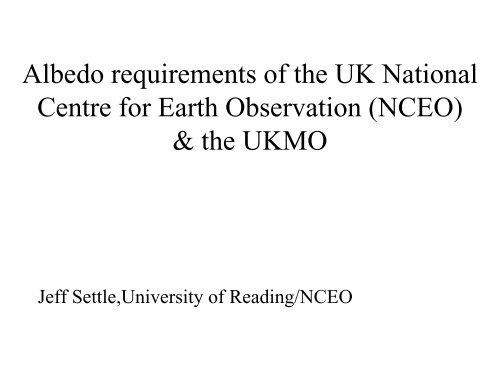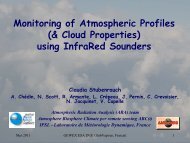Create successful ePaper yourself
Turn your PDF publications into a flip-book with our unique Google optimized e-Paper software.
Albedo requirements of the <strong>UK</strong> National<br />
Centre for Earth Observation (NCEO)<br />
& the <strong>UK</strong>MO<br />
<strong>Jeff</strong> <strong>Settle</strong>,University of Reading/NCEO
RADAGAST - Radiative flux studies in<br />
the Sahel (an AMMA-related project)<br />
MOSES, JULES, and the <strong>UK</strong>MO<br />
requirements for satellite albedo<br />
products
RADAGAST<br />
(Radiative Atmospheric Divergence using ARM<br />
mobile facility, GERB data and AMMA STations)<br />
Broad band flux data from geostationary orbit are<br />
combined with continuous surface measurements to<br />
give the first temporally well-sampled estimates of<br />
flux divergence across the atmosphere - (i.e. the<br />
amount of radiation absorbed in the atmosphere).<br />
Has to be estimated as a residual. Estimates of this<br />
(global average) vary from 67 Wm –2 (Kiehl & Trenberth<br />
1997) to 95 Wm –2 (Wild et al 1995).
RADAGAST Methodology<br />
1. Observe the top of<br />
atmosphere fluxes<br />
using the GERB and<br />
SEVIRI instruments<br />
on Meteosat<br />
2. Observe the surface fluxes<br />
using the ARM sites and use<br />
additional data to<br />
characterize the fluxes over<br />
the GERB footprint<br />
3. Calculate the flux<br />
divergence across the<br />
atmosphere as the difference<br />
between the surface and top<br />
of atmosphere fluxes<br />
GERB determines the spatial scale at which comparisons must<br />
be made: ~ 50km at surface
The RADAGAST Surface Sites<br />
Evidently, the ground<br />
station (AMF = ARM<br />
Mobile Facility) at<br />
Niamey airport<br />
belongs to a GERB<br />
pixel (large squares)<br />
that is not very<br />
uniform. A second<br />
set of instruments<br />
seem to have been<br />
better placed.<br />
How does this affect<br />
the comparisons we<br />
make/made?
Sampling Error in the Surface Radiation<br />
Budget<br />
SRB = SW ↓−SW ↑+LW ↓−LW ↑<br />
= SW ↓ 1− a<br />
( ) − εσT s<br />
a = surface albedo<br />
U = SRB AMF − SRB GERB<br />
( )<br />
4 4<br />
+ ε LW ↓−σTS<br />
We need to estimate E U<br />
( ) and Var U<br />
( ).
Components of the Sampling Error<br />
We decompose U as the sum of 5 components<br />
U = U 1 + ... U 5<br />
Where each component is of the form:<br />
p × ( FGERB – F ) AMF or F × ( pGERB – p ) AMF<br />
where F is a flux and p a surface parameter. For example<br />
U1 = ( 1−a ) ( AMF SW ↓AMF −SW ↓ ) GERB<br />
U2 = SW ↓ ( GERB aGERB − aAMF), etc.<br />
(Random)<br />
(Systematic)
Albedo variability within GERB pixels, and<br />
GERB–AMF albedo differences<br />
(1 GERB pixel = 10 4 MODIS pixels)
Sampling errors (“U”) by month<br />
Albedo U1 U2 U3 U4 U5 U<br />
Jan 0.252 ±2.06 8.45 ±1.70 -4 0 4.45±2.26<br />
Feb 0.255 ±2.35 10.04 ±1.86 -4 0 6.04±2.21<br />
Mar 0.266 ±3.44 10.58 ±2.30 -4 0 6.58±3.20<br />
Apr 0.259 ±3.85 11.45 ±2.85 -4 0 7.45±3.40<br />
May 0.234 ±7.80 10.39 ±2.66 -4 0 6.39±7.89<br />
Jun 0.226 ±5.60 10.07 ±2.32 -4 0 6.07±6.03<br />
Jul 0.222 ±9.12 9.34 ±1.64 -4 0 5.34±9.34<br />
Aug 0.196 ±12.00 8.87 ±1.63 -4 0 4.87±12.2<br />
Sep 0.200 ±6.89 9.06 ±2.65 -4 0 5.06±7.00<br />
Oct 0.226 ±4.77 10.08 ±2.15 -4 0 6.08±4.66<br />
Nov/Dec 0.248 ±3.25 9.67 ±1.29 -4 0 5.67±3.10<br />
Random part of the sampling error vs day-to-day SRB variability<br />
Jan Feb Mar Apr May Jun Jul Aug Sep Oct Nov Dec<br />
SRB 52.7 70.1 73.4 86.7 96.1 114 116 122 116 101 65.0 45.9<br />
σ(SRB) 7.12 6.7 9.9 8.0 20.8 20.6 38.6 40.4 37.2 15.8 6.6 4.4<br />
U 2.26 2.21 3.20 3.40 7.89 6.03 9.34 12.2 7.00 4.66 5.67 -
Correcting for the systematic<br />
albedo error<br />
Why not correct the upwelling short wave<br />
flux observed using the average MODIS<br />
albedo value over the GERB pixel?
How well does MODIS capture<br />
the spatial variability in albedo?<br />
DABEX (Dust and biomass experiment) January 2006<br />
FAAM = FACILITY for AIRBORNE ATMOSPHERIC MEASUREMENTS
Flight from NIA to BAN, 500ft 10:30 19th January 2006<br />
BB Albedo calculated every second
FAAM albedo vs MODIS albedo<br />
NB: “Adjustment” is to increase the MODIS value by 13-14%
Albedo comparisons<br />
through the year<br />
(2006).<br />
Black figures are<br />
MODIS;<br />
the red line is the<br />
median observed value<br />
over the same period,<br />
the blue lines are the<br />
minimum and<br />
maximums in each<br />
period. (AMF albedos<br />
calculated over 11:00-<br />
13:00)
Daily albedo at NIA airport<br />
(total all-day SW↑÷ total SW↓)<br />
Possible bias if<br />
cloudy days’<br />
albedos are very<br />
different from<br />
those on clear<br />
days
Treatment of the Land Surface in<br />
the Unified Model<br />
Original scheme: MOSES (Met Office Surface Exchange<br />
Scheme). “Effective” parameters defined at scale of<br />
atmospheric grid cell.<br />
2001- MOSES2. Land surface in each cell is now a mosaic<br />
of smaller tiles with different surface cover types. Fluxes<br />
calculated for each tile and combined.
Four options:<br />
Albedo from file<br />
Albedo in the UM<br />
Albedo for each tile: either fixed as a function of cover<br />
type, or as a function of LAI and SZA using Sellers’ 2stream<br />
model. LAI can be imposed, or generated from a<br />
dynamic vegetation model (TRIFFID in the case of the<br />
UM). Soil albedo given as fn(soil colour).<br />
Landcover from file, albedo as fn(landcover)<br />
LAI from file, albedo from canopy RT model (currently Sellers<br />
1985) as fn(LAI, SZA, soil colour, landcover)<br />
Dynamic Veg. Model –> LAI –>Albedo (canopy RT)
JULES<br />
Further development of the Land component of the Met<br />
Office/Hadley Centre GCM takes place in a complex<br />
scheme known as JULES (Joint <strong>UK</strong> Land Environment<br />
Simulator).<br />
Based on MOSES2, as currently used in the Unified<br />
Model.<br />
Being developed to model the carbon cycle, the nitrogen<br />
cycle, hydrology applications, crop modelling,etc. and<br />
general Earth System Modelling.<br />
Open to ‘the community’, code is free.<br />
http://www.jchmr.org/jules/
The Spectral Simulator<br />
This is a collection of ‘observation operators’ being<br />
developed to predict top-of-canopy and top-ofatmosphere<br />
radiances for a given set of surface<br />
parameters. Predicts surface reflectance/albedo,<br />
temperature (emissivity?) and microwave emission.<br />
Comparisons with albedo/surface reflectance products<br />
will be critical. (Timescale ~ 3-4 years)<br />
BRF product (directional reflected radiance) might be<br />
even more important for exercising surface models.<br />
The JSS is an important part of the Land Data<br />
Assimilation Scheme under development for JULES
Value of GlobAlbedo to <strong>UK</strong>MO<br />
Adding to long - term climate record<br />
Model evaluation<br />
- resolving diurnal cycle of net radiation<br />
- seasonal cycle of albedo - large uncertainties<br />
between models.<br />
- improvement of JULES, the surface scheme<br />
(MODIS already used for this)<br />
Potential for real-time assimilation?<br />
Data for reanalyses
Incorporation of improved albedo in the Hadley Centre Model<br />
From CLASSIC report, 2006
From CLASSIC report, 2006
Improved Albedo in the Hadley centre GCM<br />
From CLASSIC report, 2006
Requirements of the <strong>UK</strong>MO for GlobAlbedo<br />
Spatial<br />
Resolution<br />
Temporal<br />
Resolution<br />
Spectral<br />
Resolution<br />
Directional<br />
requirement<br />
NWP Climate<br />
1km resolution<br />
for some runs<br />
NRT?<br />
Hourly radiation<br />
calculations<br />
BB, VIS/NIR BB, VIS/NIR<br />
(defn of NIR?)<br />
N216 (~60km) in 3-5 years time.<br />
10 day average, and 10 day average of diurnal cycle<br />
(hourly radiation calculation in near future)<br />
Nothing Calibration of the vegetation sub-models in JULES<br />
Other format: netcdf, please.<br />
price: free, please<br />
Well-characterised errors and unce rtainties must be provided for all<br />
products (esp. for NRT DA)
Conclusions<br />
• Experience of the MODIS albedo has been very<br />
positive (RADAGAST, calibration of MOSES-2).<br />
• <strong>UK</strong>MO very interested in GlobAlbedo. Will be<br />
used<br />
– in climate studies for: calibration, initialisation,<br />
validation of JULES<br />
– in high resolution mode as ancillary data for NWP<br />
– via DA in NRT(?)<br />
– in reanalyses<br />
• Products at a range of resolutions (1- 60km,<br />
90km).<br />
• Product should factor in the diurnal cycle.<br />
• Products must have well characterised errors.








